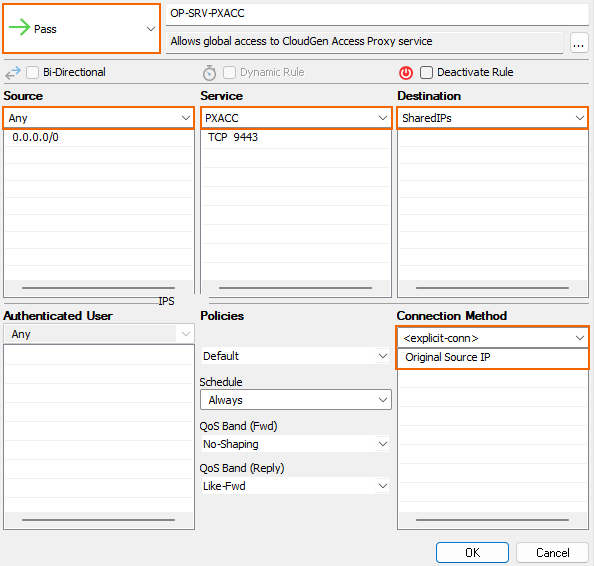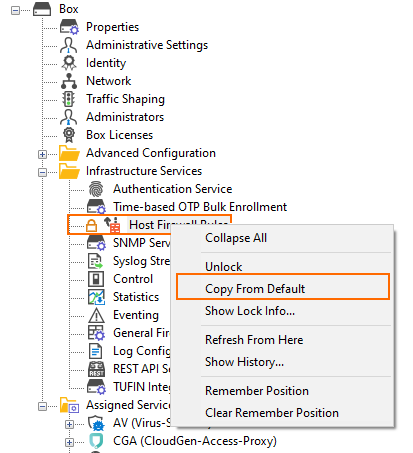The CloudGen Access Proxy is a service that brings secure access to your network resources. Unlike VPN, CloudGen Access provides secure access to enterprise resources on a per-user / per-device basis without the drawback of giving a user total access to a complete private network. As part of three main components, the CloudGen Access Proxy is the instance that effectively grants or denies access to the flow of packets between an access app and a special network resource.
Before You Begin
- IMPORTANT: Ensure that the timebase of your firewall is configured correctly!
For more information, see How to Configure Time Server (NTP) Settings. - Ensure that you are familiar with the architecture of the CloudGen Access suite of apps and services.
For more information, see Overview. - Ensure that CloudGen Access Enterprise Console is up and running and all necessary users and devices are registered.
For more information, see CloudGen Access Console. - Ensure that you have already installed the CloudGen Access App on your client device.
- Ensure that you have licensed Energize Updates.
For more information, see How to License a CloudGen Firewall. - Ensure that you have a valid Access Key. This key is a URL that is necessary for the CloudGen Access Proxy service to connect to the CloudGen Access Enterprise Console.
For more information, see Add Proxy. - You must be familiar with creating an assigned service. For more information, see How to Assign Services.
For more information on how to configure Shared Network and IPs, see Understanding the Usage of Operational-Relevant IP Addresses on the CloudGen Firewall, and How to Configure Shared Networks and IPs, and Assigned Services.
Step 1. Configure the CloudGen Access Proxy Service
- On a stand-alone firewall: Go to CONFIGURATION > Configuration Tree > Box > Assigned Services > CloudGen Access Proxy > CloudGen Access Proxy Configuration.
On a Control Center for a managed firewall: Go to CONFIGURATION > Configuration Tree > Multi-Range > your range > your cluster > Boxes > your box > Assigned Services > CloudGen Access Proxy > CloudGen Access Proxy Configuration. - Click Lock.
- For Enable CloudGen Access, select yes.
- For Listening Port, enter
9443. - For Access Key:
- For New, copy the URL from the CloudGen Enterprise Console in the corresponding edit field.
- For Confirm, re-enter the access key in the corresponding edit field.

Step 2. Enable an Access Rule to Allow Global Access to the CloudGen Access Proxy Service
If you have upgraded your firewall to support the CloudGen Access service via a hotfix, you must add an access rule to the host firewall to allow global access to the CloudGen Access Proxy service. This is referred to as Option #1 below.
In case you have not already modified the ruleset on the host firewall, you can also rebuild it with the new access rule included by copying it from the default. This is referred to as Option #2 below.
Option 1: Add an Access Rule to the Host Firewall Ruleset
- On a stand-alone firewall: Go to CONFIGURATION > Configuration Tree > Box > Infrastructure Services > Host Firewall Rules.
On a Control Center: Go to CONFIGURATION > Configuration Tree > Multi-Range > your range > your cluster > Boxes > your box > Infrastructure Services > Host Firewall Rules. - Click Lock.
- Click the green + in the upper-right corner at the top of the list.
- The Edit Rule:New Rule window is displayed.
- For the rule type, select Pass.
- For the name of the rule, enter
OP-SRV-PXACC. - Enter a description, e.g.:
Allows global access to CloudGen Access Proxy service. - For Source, select Any.
- For Service, select PXACC from the list.
- For Destination, select SharedIPs.
- For Connection Method, select Original Source IP.

- Click OK.
- Click Send Changes and Activate.
Option 2: Rebuild the Host Firewall Ruleset
- On a stand-alone firewall: Go to CONFIGURATION > Configuration Tree > Box > Infrastructure Services.
On a Control Center: Go to CONFIGURATION > Configuration Tree > Multi-Range > your range > your cluster > Boxes > your box > Infrastructure Services. - Right-click Host Firewall Rules.
- From the list, select Lock.
- Right-click Host Firewall Rules.
- From the list, select Copy From Default.

Step 3. Verify the Access Rule
On a stand-alone firewall: Go to CONFIGURATION > Configuration Tree > Box > Infrastructure Services > Host Firewall Rules. On a Control Center: Go to CONFIGURATION > Configuration Tree > Multi-Range > your range > your cluster > Boxes > your box > Infrastructure Services > Host Firewall Rules.
The access rule is located in the section for operative services and can be identified by its name OP-SRV-PXACC.
